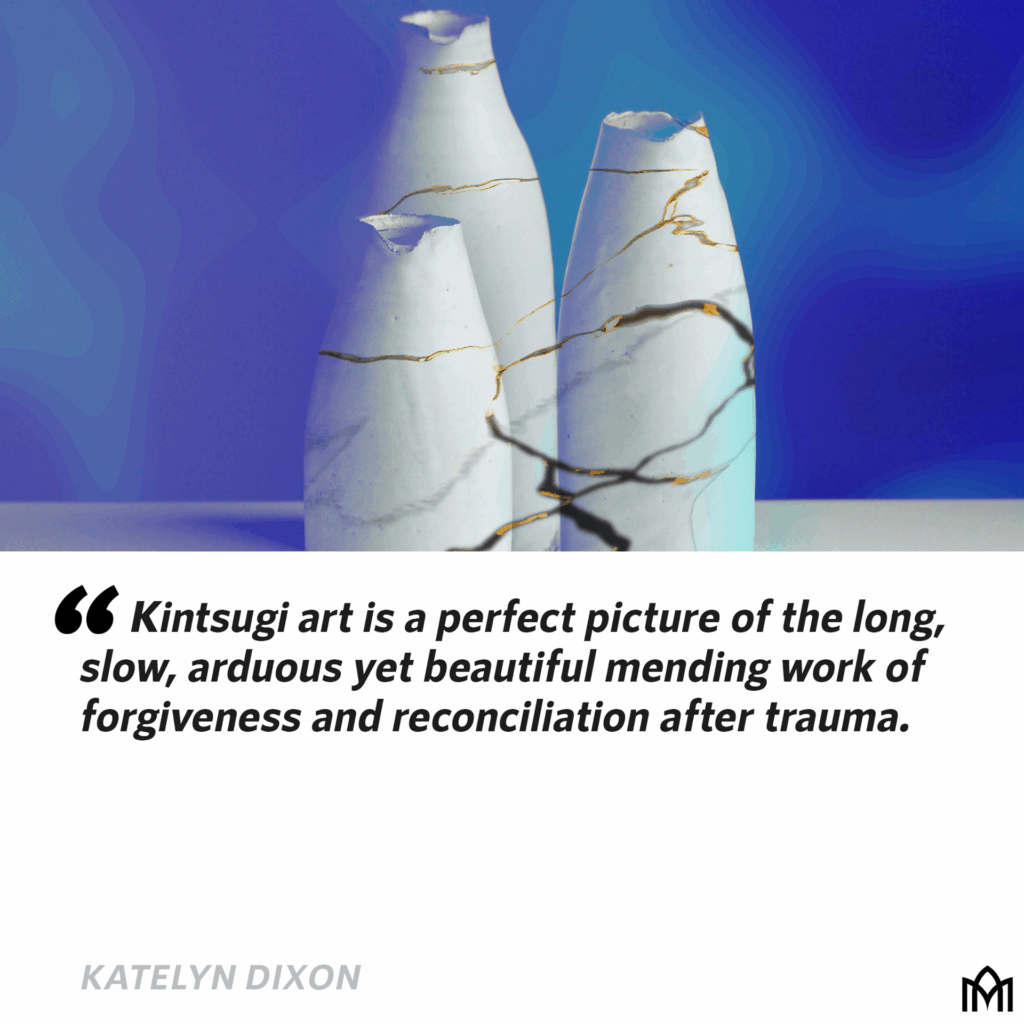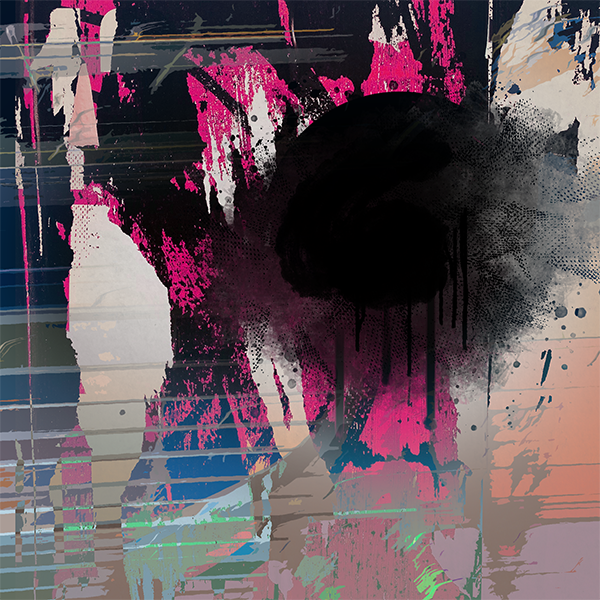Kintsugi Kingdom: Forgiveness as Mending
Kintsugi is an artistic practice that has become a precious spiritual reality to me over the past decade—ever since divorce shattered my life into a million pieces in my mid-twenties. Kintsugi is the ancient Japanese art of mending broken pieces of pottery with glue and gold, increasing both the value and beauty of the piece through its brokenness and mending. I first became aware of the artistic concept when encountering the writing of Makoto Fujimura, an artist and theologian whose work and character I deeply respect. In his book Art + Faith, Fujimura describes kintsugi-informed mending as “moving through our pain and trauma into a beautiful place.”1Makoto Fujimura, Art + Faith (New Haven: Yale University Press, 2020), 49.
Imagine my delight when Makoto Fujimura was named as one of the keynote speakers at Awakenings 2025, the Missio Alliance National Gathering in DC earlier this year, an event my husband and I attended. When he took the stage with his wife Haejin Shim Fujimura, I leaned in, eager learn more about kintsugi as an artistic mending practice. It didn’t take long before Fujimura shared a gem that has stayed with me since. As Makoto spoke, I furiously scribbled this line my journal:
“The master kintsugi artist often lets the broken pieces lie there for a long time, so he can behold them and consider the best and most beautiful way to bring the pieces back together.”
Until that point, I had imagined that the kintsugi master was simply putting the broken pieces back together, like a puzzle. I had never considered that there might be an artistic strategy of re-creation at work, in which the broken pieces are often re-filed to fit just so—perhaps mirroring the curve or jagged edge of another piece, but never fitting into the broken space in quite the same way it did before. This makes kintsugi art a perfect picture of the long, slow, arduous yet beautiful mending work of forgiveness and reconciliation after trauma.
The Shattering
Trauma shatters us. When confronted with insurmountable, uncontrollable pain, the illusion of our secure lives falls apart. Death, betrayal, a scary diagnosis, and loss can undo us in a single moment—toppling the life that we once thought firm and unshakeable into broken pieces on the floor. And those pieces can take a lifetime to come back together, yet what we are re-pieced into is never quite the same as before. How could it be?
At the most fundamental level of our personhood, suffering changes us. What we will become as a result is entirely up to how we respond to the trauma that undoes us. Will we let pain be our permanent undoing, or will we allow ourselves to be re-created by the One who holds all things together? The kintsugi master knows this struggle, and is not afraid of it—which is why he or she is content to let the pieces lie broken open in thoughtful wonder, considering the “more,” or the “new creation” this vessel could become. Having walked through death and into resurrection for our sake, our divine Kintsugi Master knows that becoming a new creation is costly. It takes time.
As counter-intuitive as it might seem, forgiving others as we are forgiven is a costly gift that God wants to give us. God knows we cannot hold the immensity of pain that comes from living with broken people in a broken world. He knows we need healing, so he gave us the internal practice of forgiveness, and invites us to re-imagine interpersonal reconciliation through the lens of his powerful love. It is the love of God that doesn’t simply toss us out when we become broken. Like a skilled kintsugi master, God is interested in more than merely fixing us; he wants to mend us and make us into a new creation. God is tender and kind, never forcing us into forgiveness or reconciliation before we are ready. He knows what will ultimately mend us, but God is content to let our broken pieces lie open until we participate with him in our own mending through the work of forgiveness and reconciliation.
Suffering changes us. What we will become is entirely up to how we respond to the trauma that undoes us. Will we let pain be our permanent undoing, or will we allow ourselves to be re-created by the One who holds all things together? Share on X
The Mending
As we follow the ‘broken-unto-wholeness’ path of our Savior, we will have to confront the forces of pain and death which have threatened to undo us. In essence, each of us are invited to echo our Savior’s call from the cross: “Father, forgive them, for they do know not what they are doing” (Luke 23:34, NIV) as we walk through our own experiences of death in this life. We may even be invited to extend forgiveness towards those who knew exactly what they were doing as they caused us harm. Forgiveness is neither excusing the other person nor trying to forget the pain they caused. It is simply releasing the other person from your need to have them pay for what they did to wound you. This is what Jesus did on the cross. He did not minimize the harm or wrongdoing of his murderers and persecutors; he simply asked the Father to release them from the need to pay for it.
Reconciliation, on the other hand, isn’t always possible or wise in this lifetime, especially when ongoing harm continues or the wounding party does not wish to reconcile or recognize their impact. Reconciliation is what Jesus did with Peter, when (after Peter denied him) Jesus approached Peter to restore their relationship. We must consider how Jesus does this. He says to Peter: “If you love me, feed my sheep” (John 21:17, NIV). With these words, Jesus is setting parameters and essentially saying to Peter, “Show me you’re serious.” This is not too much to ask those who have wounded and betrayed us, with whom we want to be in continued relationship. Trust takes time, and must be rebuilt. Reconciliation requires work from both parties—the wounded and the wounding. Whereas internal forgiveness and release is a personal practice that can go a great way towards mending “me,” reconciliation (when possible, safe, wise) is a relational practice that mends “us.”
In all of this, we must remember that forgiveness and reconciliation are not normal human things. They do not come naturally to us. Ultimately, forgiveness and reconciliation are Kingdom of Heaven realities that show us what it looks like for God’s will to be done on earth as it is in heaven. Forgiveness and reconciliation are vital components of the glue that God uses to repair the shattered pieces within us and among us. As Psalm 103:3 in The Message says, “He forgives your sins–every one. He heals your diseases–every one.” Do you see the connection between forgiveness and healing in those verses? This tells me that the forgiving love of God contains within it power to heal both the wounded and the wounding, making both forgiveness and reconciliation possible.
Forgiveness is neither excusing the other person nor trying to forget the pain they caused. It is simply releasing the other person from your need to have them pay for what they did to wound you. This is what Jesus did on the cross. Share on X
The Artist
Broken on our behalf, Jesus has gone before us and knows just what we need. He knows how long the pieces need to lie broken open and which pieces need to be re-shaped for the new creation we are becoming. While forgiveness and reconciliation are the radiant mending practices that Jesus—through being broken open for our sake—used to heal the world, it is Jesus himself who is our gold. Jesus—his life, death, and resurrection—is the gold that beautifies us, filling in our broken spaces, softening our jagged edges with the resurrection radiance of his very self. Christ in us and among us truly is our hope of glory (Col. 1:27, NIV).
Once the master Kintsugi artist has re-shaped us for his glory, as a new creation we are invited into a new purpose. We are not mended with gold simply to be put back up on the shelf as a dust-gathering display piece. Instead, we are healed and illumined to pour out the same healing, forgiveness, and reconciling power that Christ himself has poured into us: we are healed as signs and symbols of the New Creation, a foretaste of eternity to come.
Reconciliation requires work from both parties. Whereas internal forgiveness and release is a personal practice that can mend me, reconciliation (when possible, safe, wise) is a relational practice that mends us. Share on X
The New Creation
Beautifully, forgiveness and reconciliation lie at the center of kintsugi’s origins. One of the primary kintsugi origin stories tells of a warlord who stopped into a tea house for some refreshment after a long journey. The warlord requested that the tea servant use his favorite tea pot, but on the way to his table, the servant dropped the tea pot and it shattered into five pieces. The warlord was so angry that he threatened to kill the servant, but then something surprising happened: The tea master stepped in and sang a song about love and forgiveness to the warlord. The warlord then agreed to spare the servant’s life, and the tea master promised to repair the broken pot.
Some time later, when the tea master presented his repaired pot, the warlord saw that it had been mended in an unusual way—and that made him angry at first. Because instead of using the traditional glue, the tea master had filled in the cracks with a glue blended with fine gold powder, a method which highlighted the broken places instead of hiding them. But the warlord quickly saw the truth: that in being mended with gold, the once broken teapot had become a new work of art that contained more beauty and value than the original, unbroken vessel.
Isn’t it the same with us?
When we become shattered and our lives lie in broken pieces on the floor, God steps in to sing us the song of his love—mending our brokenness with the golden glue of forgiveness, binding us up, making us a new creation. Forgiveness is the glue that God uses to bind us to himself; it is the loving choice God makes to mend our fractured relationship with him. When we receive God’s forgiveness, we receive God’s mending in our brokenness. And beyond internal forgiveness, reconciliation is an interpersonal tool God has given us to restore our relationship with others. But here’s the catch–we cannot forgive or reconcile with others if we have not experienced forgiveness and reconciliation ourselves. And sometimes even after we receive God’s forgiveness, we forget to extend that same mercy and kindness to ourselves.
Each of us carry scars that tell a story. I wonder: What story do your scars tell? Is it a story you want to share, or to hide? The beautiful truth is that these scars—our cracked and broken places—can be the very thing that reveals God’s glory. I wonder how many of us still carry shame over our wounds. For the longest time, I carried shame over my divorce, believing that if I had just made better choices—essentially if I had been perfect—then I never would have been broken, and I would have never needed God to forgive me for my part in my broken marriage. My scars told a story that I wanted to hide. Eventually, God helped me to receive his mercy and grace over the part I had played. I began to see that somehow, the story of redemption God was telling through my scars was more beautiful than if I had never been broken. Two years after my divorce, I wrote a long letter of forgiveness to myself and signed my name at the bottom. When shame resurfaces, I remember that letter. Though reconciliation with my former husband is neither safe nor wise in this lifetime, a day may come in the New Heavens and Earth when I will see him and extend the same reconciling grace that God has given me.
In Art + Faith Makoto Fujimura writes, “Through the fissures of our broken journeys, with pieces of our own hearts shattered on the ground, we journey by God’s grace into the New Creation. God sees beyond our shattered remains. He picks them up and sings a song over us.”2Makoto Fujimura, Art + Faith (New Haven: Yale University Press, 2020), 43.
What song has God given you to sing over the broken pieces you see around you? Who are you being invited to call into mending—to call back to life? This is the message of reconciliation God has entrusted to each of us. Ultimately, we are working towards the reconciliation of all things: families, neighborhoods, churches, cities, nations, and races. But the important thing is for us not to be daunted in the face of all the mending work that still needs to be done. We simply start where we are. As we practice forgiveness and reconciliation on earth, we are preparing for the day when heaven and earth will be one: reconciled, joined, mended together. This is the ‘now and not yet tension’ of the New Creation.
Therefore, if anyone is in Christ, the new creation has come: The old has gone, the new is here! All this is from God, who reconciled us to himself through Christ and gave us the ministry of reconciliation: that God was reconciling the world to himself in Christ, not counting people’s sins against them. And he has committed to us the message of reconciliation. (2 Cor. 5:17-19, NIV)
As the forgiven and reconciled people of God, we are called to follow Christ in the mending ministry of forgiveness and reconciliation as we join the song of New Creation—the reconciliation of heaven and earth into a Kintsugi Kingdom, where all our broken pieces will be joined into a glorious, gold-mended whole.
///
Once the master Kintsugi artist has re-shaped us for his glory, as a new creation we are invited into a new purpose. We are not mended with gold simply to be put back up on the shelf as a dust-gathering display piece. Share on X




